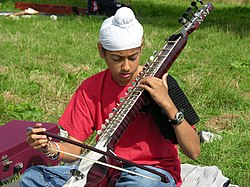Esraj
This article needs additional citations for verification. (July 2018) |
 A Sikh boy playing the Esraj | |
| String instrument | |
|---|---|
| Other names | Israj |
| Classification | Bowed string instrument |
| Developed | 17th century |
| Playing range | |
| 5-6 Octaves | |
| Related instruments | |
Esraj is an Indian stringed instrument found in two forms throughout the Indian subcontinent. It is a relatively recent instrument, being only about 300 years old. It is found in North India, primarily Punjab, where it is used in Sikh music and Hindustani classical compositions and in West Bengal. The esraj is a modern variant of the dilruba, differing slightly in structure.
Dilruba and its variant, the Esraj, had been declining in popularity for many decades. By the 1980s, the instrument was nearly extinct. However, with the rising influence of the "Gurmat Sangeet" movement, the instrument has been once again attracting attention. Rabindranath Tagore made this instrument mandatory for all the students of sangeet bhavana of Shantiniketan. Esraj is the main accompanying instrument for rabindra sangeet in Shantiniketan.[1]
History
Esraj is the modern variant of Dilruba. Dilruba was created some 300 years ago by the 10th Sikh guru, Guru Gobind Singh, who based it on the much older, and heavier, Taus[2][3] This made it more convenient for the Khalsa, the Sikh army, to carry the instrument on horseback.[1]
According to the folklore, Esraj was created by Ishwari Raj, a musician who lived in Gayadam.
Construction styles
The dilruba and its variant, the esraj, have a similar yet distinct construction style, with each having a medium-sized sitar-like neck with 20 heavy metal frets. This neck carries a long wooden rack of 12–15 sympathetic strings,known as the taraf strings,and 2-3 jawari strings.By the jawari strings one can give emphasis on the vadi,samvadi,nayeshwar notes. Jawari helps in producing a more piercing sound.Sometimes there is no jawari strings.The dilruba has more sympathetic strings and a differently shaped body than the esraj, Esraj has four main strings while Dilruba has 6 both which are bowed. All strings are metal. The soundboard is a stretched piece of goatskin similar to what is found on a sarangi. Occasionally, the instrument has a gourd affixed to the top for balance or for tone enhancement.There are two variants of esrajs played in shantiniketan, the traditional one,and the modern model developed by Pt.Ranadhir Roy,which is bigger in size.The newer model has a larger amplifier or a larger soundbox, which is perforated.An instrument maker of Kolkata, named Dulal Patra worked to develop the newer model of Esraj as per Ranadhir Roy's instructions.
Playing
The instrument can be rested between the knees while the player kneels, or more commonly rested on the knee of the player while sitting, or also on the floor just in front of the player, with the neck leaning on the left shoulder.Only the esraj players of Shantiniketan,keep the esraj erect by resting it on their lap.It is played with a bow (known as a "gaz"), with the other hand moving along the strings over the frets. The player may slide the note up or down to achieve the portamento, or meend.The Esraj can imitate the " gamak" of vocal music and by using the middle finger one can create "krintan". Pt.Ranadhir Roy used sitarbaz,sarodbaz and esrajbaz in his compositions.
Notable figures
- Asian Music Circle, used in George Harrison's "Within You Without You"
- Pandit Shiv Dayal Batish
- Ravi Shankar
- S. N. Bose
- Joel Goldsmith
See also
References
- ^ a b "Rarely played Indian instruments". Radioandmusic.com. 2018-03-29. Retrieved 2020-01-26.
- ^ Dutta, Madhumita (2008). Let's Know Music and Musical Instruments of India. Star Publications. pp. 22–23. ISBN 978-1-9058-6329-7.
- ^ Dharam Singh (2001). Perspectives on Sikhism. Publication Bureau, Punjabi University. p. 158. ISBN 978-8-1738-0736-7.
